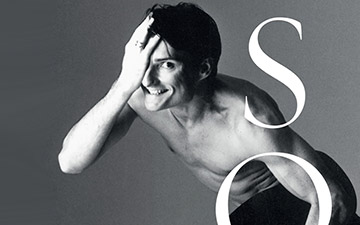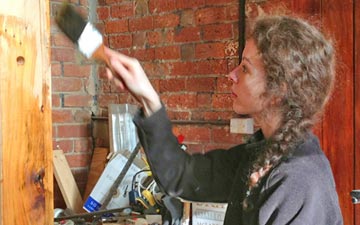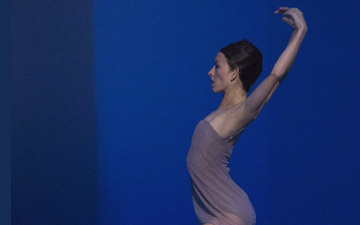
© Lynette Wills. (Click image for larger version)
Juliet Burnett (a Senior Artist with Australian Ballet) has been in unchartered territory – injured and offstage for the first time in over 10 years. We have been following her rehab: a fascinating insight into the private reality of dancers’ lives…
Part 2 of this blog
Part 3
Part 4 and back on stage
www.australianballet.com.au
www.behindballet.com/author/juliet-burnett/
The remarkable pain threshold of dancers, but particularly ballet dancers due to the nature of pointe work, is a fairly widely-known phenomenon. “Suffer for your art” and “no pain no gain” are phrases that have been embedded in the dancer’s psyche, and although antiquated, the reality seems to be that in the relentless and demanding clockwork of the ballet company, the stoic and brave succeed. But something’s got to give – we are human, after all. How brave is too brave? How far can the pain threshold be pushed?
I’ve been virtually injury-free in my ten-and-a-half years as a professional ballet dancer. I put this down to a few things – good genetics, a philosophy of “prevention is better than cure” with Pilates as a crucial accompaniment to daily ballet class, and my practice of going straight in for treatment of any minor ailment. That isn’t to say I’ve been entirely pain-free, though. It is unrealistic to expect to dance without at least some discomfort or physical restriction. Even those whose bodies seem to be purpose-built for a ballet career will have their problem areas. How natural is it, after all, to push the body to its limit the way we do every day? What I thought I had fairly down pat – perception of different degrees of pain, i.e. how much pain is safe to dance through – I would soon be forced to rethink. In this art form, pain is an inevitability.
It wasn’t until a few years ago that, when my workload increased as I danced more demanding roles, I felt the need to plunge my foot in ice every night – Maintenance Icing, I’d call it. Occasionally the second metatarsal area on my right foot would bother me with a slight throbbing pain, so I would see the physio and get it treated; often it would be such a minor issue that I’d be given clearance to dance through it, with caution of course. I would joke that, with icing now a mundane daily ritual, I had killed off all the nerve endings in my skin. Upon return to work after a break, I got into the habit of carefully ramping up my classwork – for example, no pointe work until I’d built up to allegro and done that for a few days, and no grand allegro until the second week. The Australian Ballet has excellent practice and understanding in this area, and rehearsal directors work with the dancers who are encouraged to take it easy and just “mark out” the material being learnt in the first days back at work.
And so it was when I returned to work after our ten-day mid-year break. Once I regained good physical condition, I worked towards my debut in La Sylphide, the second variation in Paquita and creating Alexei Ratmansky’s Cinderella. It sounds like a lot but we are used to such a workload in the company. I’m happiest when I have a varied repertoire to stimulate me. This particular combination of styles I found really stretched me physically – from controlled and regal classicism in Paquita to vivacious speed and ethereality in Sylphide to alternating between fluid and furious (depending on which role I was working on that day) in Cinderella. I maintained a tailored Pilates and exercise program to keep me on top of things. Pain at this stage was not a concern.

© Lynette Wills. (Click image for larger version)
At the end of the first week of shows of the Sylphide/Paquita season, I performed my first show as La Sylphide in the matinee, and then my second Paquita show in the evening. I was soaring on remnant adrenaline through the evening show, but despite still being pain-free as far as I could perceive it, when I iced my foot afterwards, I had a gut feeling that something wasn’t right. I recovered well after a rest on Sunday so didn’t feel the need to alert one of our physios, but by the middle of the week, with Cinderella rehearsals in full swing during the day and Paquita and Sylphide shows in the evening, the cramping in my right foot started. What I didn’t know until later was that this was a telltale sign of bony injury. The other thing I didn’t know was that ibuprofen, which I had decided to start taking in my determined effort to stay onstage, inhibits bone repair. With a busy week in the rehearsal studio, I couldn’t find time for a physio appointment. Because of my inexperience, I wasn’t aware that I had already overstepped the pain threshold.
On Friday morning, I woke up and couldn’t put weight on my right foot due to a sharp pain. It’ll sort itself out, I thought, thinking I had slept with it squashed under the duvet somehow, and that a bit of blood flow to the area would help. Class felt fine on ibuprofen, though I did explain to a very understanding Alexei that I would only mark out rehearsal that day. Without the show that night, I went home to rest, hoping it would feel better the next morning so I could dance my last Paquita.
But it felt worse. The pain was sharper now. I made a physio appointment before class, and had opted not to have medicine that morning so as not to mask the pain. I limped into the theatre, where the physio assessed me, gently pressing around the metatarsals to pinpoint tender areas. That feeling in my gut returned, accompanied by telltale butterflies. “If I can’t walk, how can I dance?” I thought to myself. I couldn’t imagine putting my pointe shoes on, let alone have thousands of eyes watching me dance alone onstage in the spotlight. My gut was right; the physio decided that the casting would be changed for that evening’s show. In ten and a half years dancing professionally, it would be the first show that I would miss due to injury.
Feeling like I existed in a grey daze, for the next couple of days I charted unfamiliar territory. It was difficult to fathom that only a few days ago I was dancing at full physical capacity. Still limping on Tuesday, I was referred to our sports doctor, who after assessment sent me off for MRI scans to check for a suspected stress fracture. I was instructed that all weight-bearing activity, including barre, was prohibited. I was surprised at my level-headedness. By this stage though, I had reconciled myself with the likelihood that I would not be ready for the premiere of Cinderella in just a few day’s time, and all I really wanted was clarification on the injury and my expected recovery timeframe. I kept reminding myself of the importance of maintaining a positive disposition when ill, as keeping the spirits up really does help with healing. The same must go for injuries.

© Juliet Burnett. (Click image for larger version)
I shuffled into the Ballet Staff office with the news, and we had to have a giggle when, like a lost orphan, I naively asked them what I should be participating in as far as rehearsals go; it was such a foreign situation for me. My priority was to heal up while maintaining as much strength and fitness as possible with non-weight-bearing exercise, so with that occupying my day, coming to rehearsals would be more occasional. I seized the opportunity to start yoga again to accompany my Pilates, which I struggled to find time for in my working week, and tried to be as vigilant about sitting still as possible.
At the end of the first week of rest, I went to get my MRI. By this stage I was able to walk properly again, albeit slowly. After the scan, I was handed the images to take to work for our sports doctor and physio to examine. About as patient as a kid on Christmas morning, and with the kind of curiosity that would put me in serious peril if I were of the feline genus, as soon as I arrived at the theatre that morning I ducked into the dressing room and held up my scans against the dressing table lights. Being as inexperienced as I am, and full of wonderment at the technology and science at work on me, I was ignorant of the signs, so I could only form my own speculative conclusion. My gaze was drawn to the area at the base of my second metatarsal, which glowed white like a warning beacon amidst an undiscerning network of greys and blacks. And running across the centre of this beacon, what looked to me like two tiny lines, which looked so clean and straight that I squinted my eyes to see whether it had been digitally superimposed. The butterflies returned.
I had to wait the weekend out before I would receive the official diagnosis from our sports doctor. Naturally, I was preparing myself for the worst, and my sleep was riddled with nightmarish flashes of my scan picture, each time the lines across the beacon magnifying and then multiplying, as if it were a scene from Fantasia. Belying this melodrama was one calm certainty. It was time to reconsider my pain threshold.

















What an amazing, clear headed piece dealing with what must have been a terrifying series of events. I saw Juliet dance the “Sylphide” lead on Thursday September 5 so, from her account, she was well and truly in trouble. However I have to say that she was my favourite of all the casts. Such wonderful open arms and a very individual approach to her dance phrasing – she seemed to vary repeated sections ever so slightly and be dancing through the music.She captured perfectly the other-worldliness of the character. Something about the makeup and hair, and her “pixie-like” expression, made one forget the ballerina and believe in the mercurial creature of the air. I am very intrigued to know what roles we missed seeing her play in the “Cinderella” season. And I hope she will give us updates as her recovery progresses.
Adrian, thank you for your kind words, they really mean a lot. I loved performing La Sylphide. While it was indeed a very scary period up until the point at which this part of the series ends, I have in the past couple of weeks (which I have written about for Part 2 of this series, to be published soon) had time to reflect on my situation and found it all a valuable learning opportunity. I am so looking forward to returning to the stage with a wealth of new knowledge within that hopefully permeates my dancing!